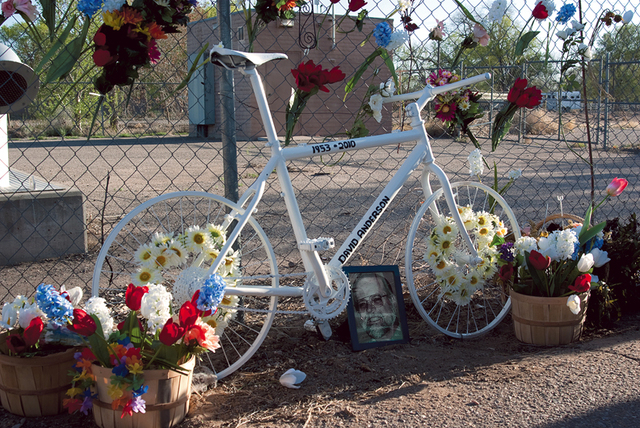Three months after cyclist David Anderson was killed near Paseo del Norte and Rio Grande Boulevard, the black auto paint smeared on a nearby brick wall is beginning to peel off. Fresh silver fencing replaced about 20 feet of rusty fence destroyed by a car careening off the road. It, too, is beginning to weather. And the flowers placed in front of Anderson’s roadside memorial have long since wilted.The memorial itself, however, sits relatively unchanged. Vibrant plastic daisies are tied between spokes; the frame is bolted into rebar lodged deep in the ground, and the bright white paint coating the body hasn’t yet faded. This is a ghost bike, erected to commemorate the place where Anderson, 56, was killed March 22 during his bike ride home along a designated path. A nonprofit organization called the Duke City Wheelmen Foundation has installed five such roadside memorials in the Albuquerque area, as well as one in Silver City, without city or state permission. The organization cites a 2007 state statute that outlaws the desecration of roadside memorials, or descansos , as its legal backing. “It just falls into the history and the tradition of our state,” says Wheelmen President Jennifer Buntz. “Not every state permits roadside memorials, but New Mexico has a long history of roadside memorials." The Wheelman Foundation says the ghost bikes are no different. "There’s no definition of what it has to look like.”But the city under the Chavez administration uprooted a ghost bike in October. It had been installed in memory of Roy Sekreta, a cyclist killed in 2008. Buntz said the Wheelmen Foundation erected a replacement and it was removed again, this time under Mayor Richard Berry and Chief Public Safety Officer Darren White. In response, the Foundation has tried to work with the city to establish guidelines for the ghost bikes. Buntz says city officials have missed meetings and broken promises.She says White told her in January that he’d discuss ghost bike guidelines at the February meeting of the Greater Albuquerque Bicycling Advisory Committee. Buntz says he didn’t show up until May. White did not respond to requests for an interview with the Alibi . And Chris Ramirez, spokesperson for Mayor Berry’s office, says Buntz is not qualified to determine whether a ghost bike is a descanso . “She’s not a judge in a courtroom, because the New Mexico state law is very specific about what a descanso is,” Ramirez says. “She is not the deciding factor of what is a descanso and what is not. That has to be interpreted by a court if it ever gets to that point.” The law does not actually make a distinction about what is and what is not a descanso. It reads, “A person shall not knowingly or willfully deface or destroy, in whole or in part, a descanso , also known as a memorial, placed alongside a public road right of way to memorialize the death of one or more persons.” T.J. Wilham, the city’s spokesperson for public safety, said while ghost bikes might not be considered descansos , city officials won’t take them down as long as the bicycles are well-maintained and safe.“Director White felt strongly that as long as it doesn’t impede traffic and as long as it stays clean, we’re fine with it. We have no issue with it,” Wilham says. “The whole talk of the legality of it is almost kind of moot.”On May 18, Maria Hinojos, a traffic engineer for the Transportation Department, e-mailed Buntz, to tell her a ghost bike installed in Silver City had to be taken down because it intruded on a highway’s traffic flow.State law allows a public official to take down a roadside memorial if it “obstructs or damages any public road in this state or to an owner of private property,” but Buntz maintains that neither the ghost bike in question nor any other New Mexico ghost bike has gotten in the way of those on the road. Buntz brought Hinojos’ e-mail to the attention of a transportation committee charged with bicycle, pedestrian and equestrian issues on May 27. A member of the committee confirmed that it intends to send letters to Transportation Department officials asking that ghost bikes be treated as descansos .Whether the city keeps its promise to leave well-maintained ghost bikes in place remains to be seen, Buntz says, but she’s optimistic. She says ghost bikes are valuable in commemorating tragedies. “Their role as an awareness device is almost secondary in some ways,” she says. “They’re very meaningful to the family and friends.” A ghost bike was installed at Comanche and Pennsylvania in February for Paula Higgins, who was killed in 2006. When the memorial was first put in, it had just one small sprig of blossoms. “Since then, it’s just covered in flowers.”And Lynn Boulware, David Anderson’s sister-in-law, says the commemoration of his ghost bike on April 13 was the first time she and many other family members had been to the spot where he was killed. She says it will serve as a reminder for those who use the path. “We just appreciate the support of the cycling community," she says, "and we just hope that something comes out of this that cyclists are protected on the bike trails."







